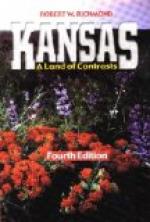One most unpleasantly suggestive equipment of an American railway carriage is the axe and crowbar suspended on the wall for use in an accident. This makes one reflect that there are only two doors in an American car containing sixty people, whereas the same number of passengers in Europe would have six, eight, or even ten. This is extremely inconvenient in crowded trains (e.g., in the New York Elevated), and might conceivably add immensely to the horrors of an accident. The latter reflection is emphasised by the fact that there are practically no soft places to fall on, sharp angles presenting themselves on every side, and the very arm-rests of the seats being made of polished iron.
There is always a smoking-car attached to the train, generally immediately after the locomotive or luggage van. Labourers in their working clothes and the shabbily clad in general are apt to select this car, which thus practically takes the place of third-class carriages on European railways. On the long-distance trains running to the West there are emigrant cars which also represent our third-class cars, while the same function is performed in the South by the cars reserved for coloured passengers. In a few instances the trains are made up of first-class and second-class carriages actually so named. A “first-class ticket,” however, in ordinary language means one for the universal day-coach as above described.
The ticket system differs somewhat from that in vogue in Europe, and rather curious developments have been the result. For short journeys the ticket often resembles the small oblong of pasteboard with which we are all familiar. For longer journeys it consists of a narrow strip of coupons, sometimes nearly two feet in length. If this is “unlimited” it is available at any time until used, and the holder may “stop over” at any intermediate station. The “limited” and cheaper ticket is available for a continuous passage only, and does not allow of any stoppages en route. The coupons are collected in the cars by the conductors in charge of the various sections of the line. The skill




